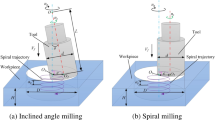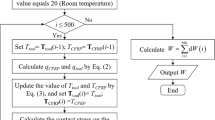Abstract
End cutting edges of tool determine machining quality of the bottom surface of the slot in end-milling of CFRP. However, due to anisotropy and heterogeneous of CFRP, and also semi-closed characteristic of blind slots, the end cutting edges are more vulnerable to wear than the peripheral edges under the strong abrasive fibers, leading to the poor machining quality of the bottom surface of the slots, and thereby decreases the assembly performance of the components. This paper aims to reveal the wear laws and mechanisms of the end cutting edge which serves under the poor machining conditions in end-milling of CFRP. In order to obtain major wear forms of the end cutting edge, the tool’s structure and the removal characteristics in end-milling of CFRP are analyzed. For acquiring the wear laws accurately, slot-milling experiments are conducted, in which the quantitative characterization of each wear form is proposed. According to the wear laws obtained from the experiments, combining with the associated relationships of each wear form, the wear mechanisms of end cutting edge are revealed, and also, the influences of the tool wear on the surface’s machining quality are got. The results show that there are three wear forms in all including the corner wear, the cutting-edge wear, and the flank wear. Concretely, the corner wear is rapid; the cutting-edge radius is fluctuating and tends to decrease, while the flank face is wearing constantly. The conclusions of this study can provide foundations for further studies on suppression of the tool wear.

















Similar content being viewed by others
Change history
10 March 2023
A Correction to this paper has been published: https://doi.org/10.1007/s00170-023-11240-4
References
Hintze W, Brügmann F (2018) Influence of spatial tool inclination on delamination when milling CFRP. J Mater Process Tech 252:830–837. https://doi.org/10.1016/j.jmatprotec.2017.10.041
Amin M, Yuan S, Khan MZ et al (2017) Development of a generalized cutting force prediction model for carbon fiber reinforced polymers based on rotary ultrasonic face milling. Int J Adv Manuf Tech 93:2655–2666. https://doi.org/10.1007/s00170-017-0469-9
Zhang B, Wang F, Wang Q et al (2021) Novel fiber fracture criteria for revealing forming mechanisms of burrs and cracking at hole-exit in drilling carbon fiber reinforced plastic. J Mater Process Tech 289:116934. https://doi.org/10.1016/j.jmatprotec.2020.116934
Furuki T, Hirogaki T, Aoyama E et al (2014) Influence of tool shape and coating type on machined surface quality in face milling of CFRP. Adv Mater Res 1017:310–315. https://doi.org/10.4028/www.scientific.net/AMR.1017.310
Hamedanianpour H, Chatelain JF (2013) Effect of tool wear on quality of carbon fiber reinforced polymer laminate during edge trimming. Appl Mech Mater 325:34–39. https://doi.org/10.4028/www.scientific.net/AMM.325-326.34
Liu G, Qian X, Chen H et al (2017) Development of a staggered PCD end mill for carbon fiber reinforced plastic. Appl Sci 7:245. https://doi.org/10.3390/app7030245
Khairussaleh NKM, Haron CHC, Ghani JA (2016) Study on wear mechanism of solid carbide cutting tool in milling CFRP. J Mater Res 31:1893–1899. https://doi.org/10.1557/jmr.2016.21
Pimenov DY, Guzeev VI, Mikolajczyk T et al (2017) A study of the influence of processing parameters and tool wear on elastic displacements of the technological system under face milling. Int J Adv Manuf Tech 92:4473–4486. https://doi.org/10.1007/s00170-017-0516-6
Kusuyama J, Yui A, Kitajima T et al (2014) Face milling of carbon fiber reinforced plastic using poly crystalline diamond tool. Adv Mater Res 1017:383–388. https://doi.org/10.4028/www.scientific.net/AMR.1017.383
Voss R, Seeholzer L, Kuster F et al (2017) Influence of fibre orientation, tool geometry and process parameters on surface quality in milling of CFRP. CIRP J Manuf Sci Tech 18:75–91. https://doi.org/10.1016/j.cirpj.2016.10.002
Nor KMK, Che HCH, Jaharah AG et al (2012) Tool wear and surface roughness on milling carbon fiber-reinforced plastic using chilled air. J Asian Sci Res 2:593–598. https://archive.aessweb.com/index.php/5003/article/view/3400. Accessed 12 Mar 2022
Han SC, Chen Y, Xu JH et al (2013) Experimental study of tool wear in milling multidirectional CFRP laminates. Mater Sci Forum 770:276–280. https://doi.org/10.4028/www.scientific.net/MSF.770.276
Han SC, Chen Y, Xu JH et al (2014) Modeling and simulation of multi-layer CFRP milling forces in side milling with multi-tooth milling. Acta Mater Compos Sinica 31(5):1375–1381. https://kns.cnki.net/kcms/detail/detail.aspx?dbcode=CJFD&dbname=CJFD2014&filename=FUHE201405037&uniplatform=NZKPT&v=JSJLXy6ioIXwOMpmM4jS-x6xCFuKb-_edIxpTVVwdb4OYC_WsWltWoPCFyPoVwPq. Accessed 20 Apr 2022
Han S, Gong Y, Yang N et al (2013) An experimental study on the cutting tool performance during milling of carbon fiber reinforced polymer. Key Eng Mater 589:179–183. https://doi.org/10.4028/www.scientific.net/KEM.589-590.179
Wang F, Qian B, Jia Z et al (2017) Secondary cutting edge wear of one-shot drill bit in drilling CFRP and its impact on hole quality. Compos Struct 178:341–352. https://doi.org/10.1016/j.compstruct.2017.04.024
Liu J, Yang X, Xu Z et al (2017) Experimental study on the tool wear in milling carbon fiber reinforced plastics. Mater Sci Forum 893:57–61. https://doi.org/10.4028/www.scientific.net/MSF.893.57
Buse H, Feinle P (2016) Model system studies of wear mechanisms of hard metal tools when cutting CFRP. Procedia Eng 149:24–33. https://doi.org/10.1016/j.proeng.2016.06.634
Zhang B, Wang F, Fan J et al (2021) Simulation and experimental analysis on influences of axial cutting-induced vibration on edge trimming quality of carbon fiber reinforced plastics. J Manuf Process 68:632–645. https://doi.org/10.1016/j.jmapro.2021.05.067
Sheikh-Ahmad J, Dhuttargaon M, Cheraghi H (2017) New tool life criterion for de-lamination face milling of CFRP. Int J Adv Manuf Tech 92:2131–2143. https://doi.org/10.1007/s00170-017-0240-2
Liu G, Chen H, Huang Z et al (2017) Surface quality of staggered PCD end mill in milling of carbon fiber reinforced plastics. Appl Sci 7:199. https://doi.org/10.3390/app7020199
Jia Z, Su Y, Niu B et al (2016) Deterioration of polycrystalline diamond tools in milling of carbon-fiber-reinforced plastic. J Compos Mater 51:2277–2290. https://doi.org/10.1177/0021998316669605
Kitajima T, Horiuchi T, Yui A et al (2016) Effect of cutting speed on the face milling of CFRP using a PCD tool. Mater Sci Forum 874:487–491. https://doi.org/10.4028/www.scientific.net/MSF.874.487
Acknowledgements
The authors wish to thank the anonymous reviewers for their comments which lead to improvements of this paper.
Funding
This work was supported by the Major Program of the National Natural Science Foundation for Young Scholars of China (grant number 52005077) and National Natural Science Foundation of China (grant number 52090053).
Author information
Authors and Affiliations
Contributions
All authors contributed to the study conception and design. Material preparation, data collection, and analysis were performed by Boyu Zhang, Gang Wei, and Fuji Wang. The first draft of the manuscript was written by Han Mu and Gang Wei; all authors commented on previous versions of the manuscript. All authors read and approved the final manuscript.
Corresponding author
Ethics declarations
Competing interests
The authors declare no competing interests.
Additional information
Publisher's note
Springer Nature remains neutral with regard to jurisdictional claims in published maps and institutional affiliations.
The original online version of this article was revised: Order of author has been changed.
Rights and permissions
Springer Nature or its licensor (e.g. a society or other partner) holds exclusive rights to this article under a publishing agreement with the author(s) or other rightsholder(s); author self-archiving of the accepted manuscript version of this article is solely governed by the terms of such publishing agreement and applicable law.
About this article
Cite this article
Mu, H., Zhang, B., Wei, G. et al. Experimental study on wear laws and mechanisms of end cutting edge in end-milling of carbon fiber reinforced polymer. Int J Adv Manuf Technol 125, 5397–5406 (2023). https://doi.org/10.1007/s00170-023-11023-x
Received:
Accepted:
Published:
Issue Date:
DOI: https://doi.org/10.1007/s00170-023-11023-x




